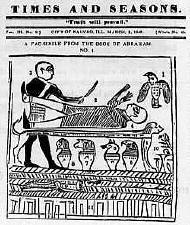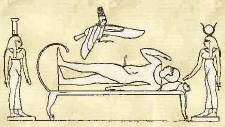|
"Isis," by Tour Egypt.Net wrote:
Among [Isis'] general titles may be mentioned those of "the divine one,
the only one, the greatest of the gods and goddesses, the queen of all
gods, the female Ra,
the female Horus, the eye of Ra, the crown of Ra-Heru,
Sept, opener of the year, lady of the New
Year, maker of the sunrise, lady of heaven, the light-giver of heaven,
lady of the North Wind, queen of the earth, most mighty one, queen of the
South and North, lady of the solid earth, lady of warmth and fire,
benefactress of the Tuat, she who is greatly feared in the Tuat, the
God-mother, the God-mother of Heru-ka-nekht, the mother of the Horus of
gold, the lady of life, lady of green crops, the green goddess (Uatchet),
lady of bread, lady of beer, lady of abundance, lady of joy and gladness,
lady of love, the maker of kings, lady of the Great House, lady of the
House of fire, the beautiful goddess, the lady of words of power, lady of
the shuttle, daughter of Seb, daughter of Neb-er-tcher, the child of Nut,
wife of Ra, wife of the lord of the abyss, wife of the lord
of the Inundation, the creatrix of the Nile flood."
"Eye
of Horus," by Byzant.com
The ancient Egyptian Eye of Horus or wedjat ('Whole One') is a powerful
symbol of protection, and is also considered to confer wisdom, health and
prosperity. Horus was one of the most important Egyptian gods, a sun-god
represented as a falcon or with the head of a hawk, whose right eye was
the sun and whose left eye was the moon. He was the son of Osiris (god of
the underworld) and Isis (mother goddess). Osiris was slain by his own
brother, the evil Set (jackal-headed god of night), and Horus fought Set
to avenge his father's death, winning the battle but losing an eye in the
process. The eye was restored by the magic of the god of wisdom and the
moon, Thoth, and this allowed Horus to grant Osiris rebirth in the
underworld. The Eye of Horus symbol was used in funerary rites and
decoration, as instructed in the Egyptian Book of the Dead. After 1200 BC,
it was also used by the Egyptians to represent fractions, based on
repeated division by two. Both the right and the left eyes of Horus were
depicted by the ancient Egyptians. The wounding of the left eye served as
a mythical explanation of the phases of the moon, and its magical
restoration meant that the left was usually the one used as an amulet and
considered to be the 'Eye of Horus'. The right eye is sometimes referred
to as the 'Eye of Ra', the sun god, though often little distinction is
made between the two eyes.
Jerald and Sandra Tanner, "Solving the Mystery of the Joseph Smith Papyri"
wrote

"This is the well-known scene from the Osiris mysteries, with Anubis, the
jackal-headed god, on the left ministering to the dead Osiris on the bier.
The pencilled (?) restoration is incorrect. Anubis should be
jackal-headed. The left arm of Osiris is in reality lying at his side
under him. The apparent upper hand is part of the wing of a second bird
which is hovering over the erect phallus of Osiris (now broken away).
The
second bird is Isis and she is magically impregnated by the dead Osiris
and then later gives birth to Horus ..." (Dialogue: A Journal of Mormon
Thought, Summer 1968, page 86)
A Scene from the Mysteries
of Osiris at Philae, by Egyptology.com wrote:

Restored scene
proposing the remembering of Osiris.
Paul Rydeen, Phil
Dick Biography wrote:
The Sirius Mystery. Temple documents the Dogon people of
Africa and their precise astronomical data which predate telescopes. Their
legends say that this knowledge was given to them by three-eyed
crab-clawed beings from Sirius. Temple goes on to trace the Dogon's
ancestors back to migrating Egyptians who continue a tradition
well-documented in the Mysteries of Isis and Osiris.
ISIS, International Studies in Schools wrote:

ISIS EVENTS GALLERY
Exploring East Asia through Storytelling:
This series, sponsored by IU's East Asian Studies Center, feature popular
folktales from China, Japan, or Korea told by a professional storyteller.
The presentations also involved an IU student from the relevant country,
who discussed modern-day issues addressed by the folktale.
This spring, three interactive presentations focused on the much-loved
Japanese folktale, "The Crane Wife". Professional storyteller Mary
Fraser performed the story of the marriage of a simple farmer and his
crane-wife who could weave enchanted cloth. Following the story, Mary
fielded student questions about the characters and meaning of the tale.
The second part of the program, was presented by IU student Yasuko Murphy
of Japan. She introduced the students to Japanese 'dancing' red-crowned,
the importance of the crane in Japanese culture and art, and recent
efforts to protect this now-endangered species.
The program was presented to Lebanon Middle School's 7th grade East Asian
study group, and to two 3rd grade classes - the students of Longfellow
Elementary School teacher JoAnn Beleslin and on the students of Grissom
Elementary School teacher Lois Johnson. Both of the elementary schools are
located in Gary, Indiana, and IU's ability to reach these two faraway
sites via the Vision Athena network once again demonstrated the
values of this distance learning technology as an outreach tool. In all
presentations, the 3rd and 7th graders asked many questions and seemed
quite at ease interacting with guest speakers who were, in fact, quite far
away. |